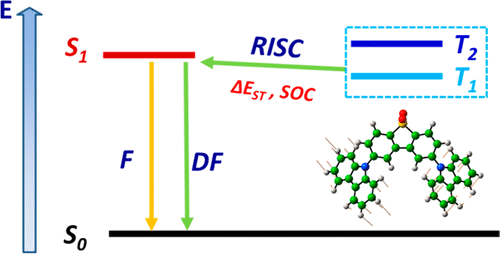当前位置:
X-MOL 学术
›
Acc. Chem. Res.
›
论文详情
Our official English website, www.x-mol.net, welcomes your
feedback! (Note: you will need to create a separate account there.)
Thermally Activated Delayed Fluorescence (TADF) Path toward Efficient Electroluminescence in Purely Organic Materials: Molecular Level Insight
Accounts of Chemical Research ( IF 16.4 ) Pub Date : 2018-08-24 00:00:00 , DOI: 10.1021/acs.accounts.8b00174 Xian-Kai Chen 1 , Dongwook Kim 2 , Jean-Luc Brédas 1
Accounts of Chemical Research ( IF 16.4 ) Pub Date : 2018-08-24 00:00:00 , DOI: 10.1021/acs.accounts.8b00174 Xian-Kai Chen 1 , Dongwook Kim 2 , Jean-Luc Brédas 1
Affiliation

|
Since the seminal work of Tang and Vanslyke in 1987 on small-molecule emitters and that of Friend and co-workers in 1990 on conjugated-polymer emitters, organic light-emitting diodes (OLEDs) have attracted much attention from academia as well as industry, as the OLED market is estimated to reach the $30 billion mark by the end of 2018. In these first-generation organic emitters, on the basis of simple spin statistics, electrical excitation resulted in the formation of ∼25% singlet excitons and ∼75% triplet excitons. Radiative decay of the singlet excitons to the singlet ground state leads to a prompt fluorescence emission, while the triplet excitons only lead to weak phosphorescence due to the very small spin–orbit couplings present in purely organic molecules. The consequence is a ca. 75% energy loss, which triggered wide-ranging efforts to try and harvest as many of the triplet excitons as possible. In 1998, Thompson, Forrest, and their co-workers reported second-generation OLED emitters based on coordination complexes with heavy transition metals (e.g., iridium or platinum). Here, the triplet excitons stimulate efficient and fast phosphorescence due to the strong spin–orbit couplings enabled by the heavy-metal atoms. Internal quantum efficiencies (IQE) up to 100% have been reported, which means that for every electron injected into the device, a photon is emitted. While these second-generation emitters are those mainly exploited in current OLED applications, there is strong impetus from both cost and environmental standpoints to find new ways of exploiting purely organic emitters, which in addition can offer greater flexibility to fine-tune the electronic and optical properties by exploiting the synthetic organic chemistry toolbox.
中文翻译:

纯有机材料中高效电致发光的热激活延迟荧光(TADF)途径:分子水平洞察
自1987年Tang和Vanslyke在小分子发射器上的开创性工作以及1990年Friend和同事在共轭聚合物发射器上的开创性工作以来,有机发光二极管(OLED)引起了学术界和工业界的广泛关注,因为OLED的市场估计到2018年底将达到300亿美元大关。在这些第一代有机发射器中,根据简单的自旋统计,电激发导致约25%的单重态激子和约75%的激子形成。三重态激子。单线态激子向单线态基态的辐射衰减会导致迅速的荧光发射,而三线态激子仅由于纯有机分子中存在很小的自旋-轨道偶合而导致微弱的磷光。结果是大约。75%的能量损失,从而引发了广泛的尝试,试图尽可能多地收获三重态激子。1998年,Thompson,Forrest及其同事报告了第二代OLED发射器,该发射器基于与重过渡金属(例如铱或铂)的配位化合物。在这里,由于重金属原子的强自旋轨道耦合,三重态激子激发了高效而快速的磷光。内部量子效率(IQE)高达100%,这意味着注入到器件中的每个电子都会发射一个光子。虽然这些第二代发射器是目前在OLED应用中主要使用的发射器,但从成本和环境角度来看,都有强劲的动力来寻找开发纯有机发射器的新方法,
更新日期:2018-08-24
中文翻译:

纯有机材料中高效电致发光的热激活延迟荧光(TADF)途径:分子水平洞察
自1987年Tang和Vanslyke在小分子发射器上的开创性工作以及1990年Friend和同事在共轭聚合物发射器上的开创性工作以来,有机发光二极管(OLED)引起了学术界和工业界的广泛关注,因为OLED的市场估计到2018年底将达到300亿美元大关。在这些第一代有机发射器中,根据简单的自旋统计,电激发导致约25%的单重态激子和约75%的激子形成。三重态激子。单线态激子向单线态基态的辐射衰减会导致迅速的荧光发射,而三线态激子仅由于纯有机分子中存在很小的自旋-轨道偶合而导致微弱的磷光。结果是大约。75%的能量损失,从而引发了广泛的尝试,试图尽可能多地收获三重态激子。1998年,Thompson,Forrest及其同事报告了第二代OLED发射器,该发射器基于与重过渡金属(例如铱或铂)的配位化合物。在这里,由于重金属原子的强自旋轨道耦合,三重态激子激发了高效而快速的磷光。内部量子效率(IQE)高达100%,这意味着注入到器件中的每个电子都会发射一个光子。虽然这些第二代发射器是目前在OLED应用中主要使用的发射器,但从成本和环境角度来看,都有强劲的动力来寻找开发纯有机发射器的新方法,











































 京公网安备 11010802027423号
京公网安备 11010802027423号